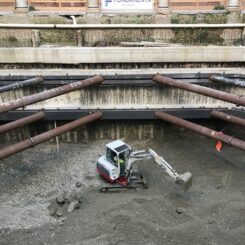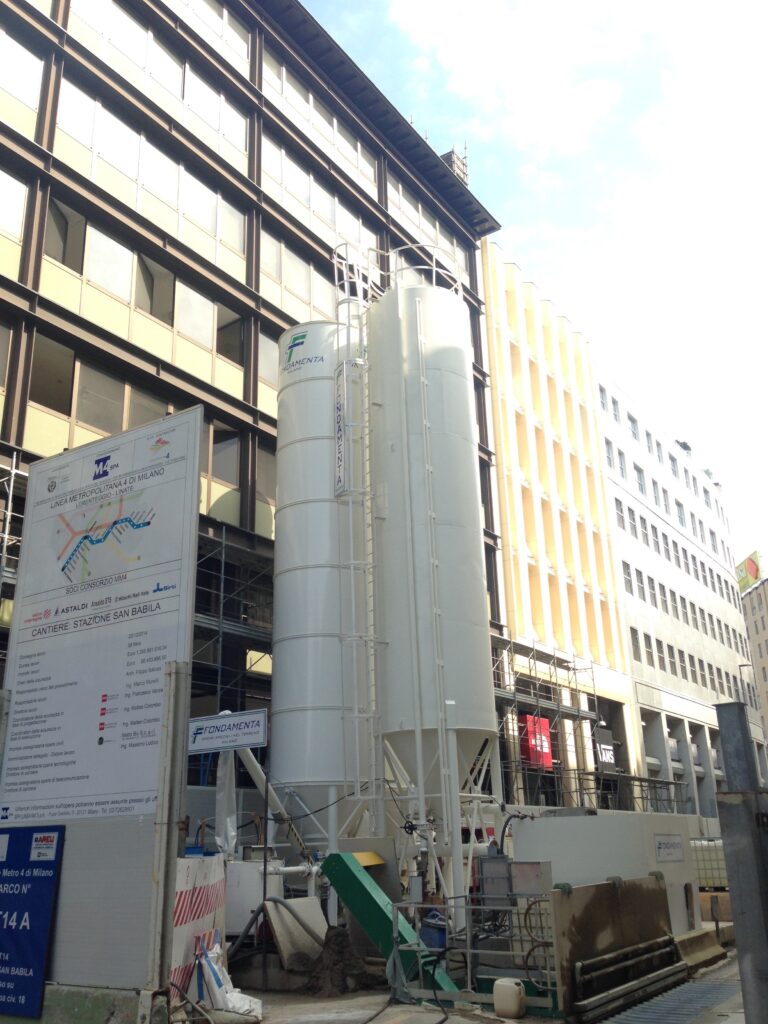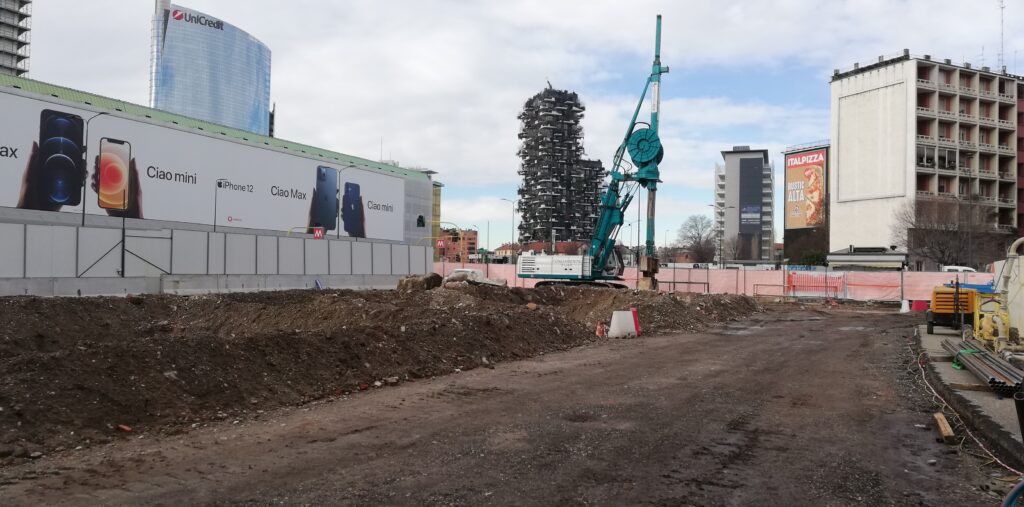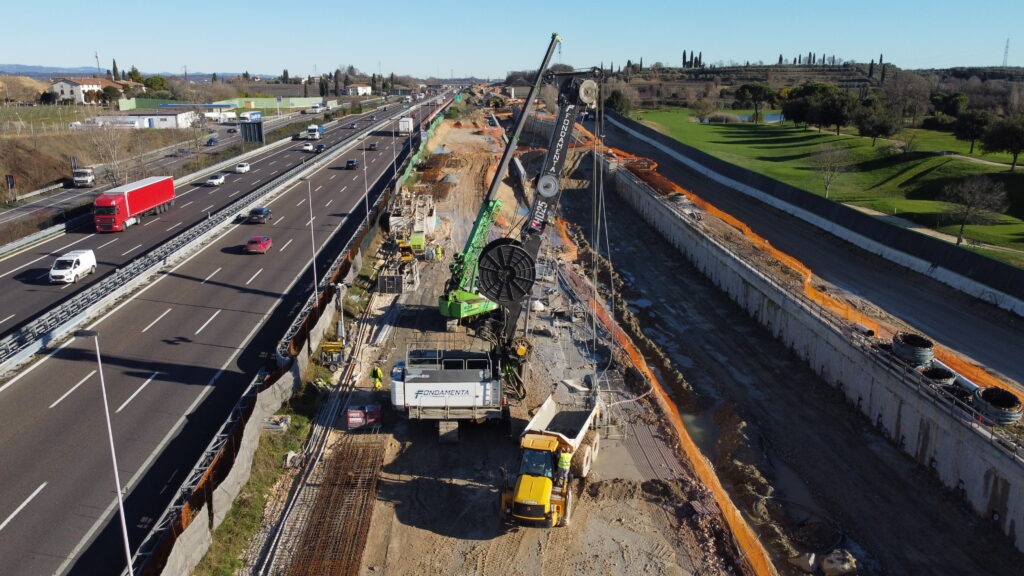Excavations and Reclamations
Fondamenta specializes in off-site excavations and reclamations, even in challenging environments like city centers. The off-site reclamation technology involves the mechanical removal of contaminated soil, which is then disposed of or treated at an authorized facility. This typically includes creating an on-site temporary storage for proper classification of the excavated soil with the necessary CER (European Waste Catalogue) code.
Soil reclamation through excavation and disposal is effective in terms of intervention efficiency, time, and costs for sites with contamination at limited depths or planned redevelopment excavations. This reliable and tested technique is applicable to any soil type, as it suits any granulometry and is independent of the pollutant type.
Excavation activities are carried out using appropriately sized mechanical excavators. Operationally, excavation and removal of contaminated soils generally proceed progressively in subsequent excavation batches and/or groups of batches, as outlined in the Approved Reclamation Project. Each batch undergoes preliminary geochemical characterization; where necessary, removed materials from each batch/polygon may be subject to further analytical characterization and managed as waste.
Fondamenta SpA has a strong technical background in characterization and reclamation, with ANGA registration no. MI 61971 of 07/25/2022 and ISO 14001 certification issued by INTERCERT no. IC-EM-2212141. Reclamation excavation is conducted selectively, assisted on the ground by qualified technical personnel to perform preliminary sorting or selection operations to separate different materials from the soil. These materials are removed from the excavation area and placed in the waste storage area for subsequent characterization/classification and disposal.
Upon completion of the excavation, analytical verification ensures compliance with target concentrations for the soils on the excavation walls and bottom, as specified in the Approved Reclamation Projects.
Operations are conducted with all necessary precautions to protect against contaminant dispersion and ensure proper activity execution, maintaining constant safety conditions for involved operators. Excavations are executed ensuring the stability of the excavation fronts and operator safety.
Fondamenta SpA approaches each off-site reclamation project with a preliminary assessment of the environmental aspects of managing excavation and reclamation materials and waste. This fundamental process helps understand and manage the environmental impact generated by such activities. This complex assessment requires an in-depth evaluation of:
- Environmental impacts
- Identification of risks and opportunities
- Development of environmental management plans and strategies to reduce overall environmental impact
Here is an overview of how Fondamenta SpA conducts such an assessment before executing a reclamation:
- Identification of Environmental Aspects: The first step is identifying and understanding the environmental aspects associated with excavation and reclamation materials and waste management. These aspects include soil contamination, air quality, water management, waste generation, greenhouse gas emissions, and other direct and indirect environmental impacts.
- Environmental Impact Assessment:Using appropriate methods and tools, the environmental impacts associated with excavation and reclamation materials and waste are evaluated throughout their lifecycle. This includes analyzing the impact on the local ecosystem, air and water quality, human health, biodiversity, climate change, and other relevant environmental factors.
- Identification of Risks and Opportunities: Based on the environmental impact assessment, potential environmental risks associated with managing excavation and reclamation materials and waste, and opportunities to mitigate negative impacts and promote more sustainable practices, are identified. In this phase, the most environmentally friendly alternatives for managing materials and waste are identified.
- Development of Environmental Management Plans and Strategies: Based on the results of the environmental aspects assessment, environmental management plans and strategies are developed to minimize negative impacts and maximize environmental benefits associated with excavation and reclamation materials and waste. These plans may include pollution prevention measures, recycling and material recovery practices, waste reduction strategies, and environmental risk management plans. These plans also provide for the technical and administrative qualification of the entire waste management chain, including the transporter, any intermediary, and the final destination site, through verifying environmental authorizations and White list registrations, where necessary.
Continuous Monitoring and Review: It is essential to monitor the effectiveness of the implemented environmental management measures and regularly review the plans and strategies based on changes in environmental conditions, regulations, and best available practices.
Below are the main general rules adopted by Fondamenta SpA for temporary storage:
- Homogeneous material storage in distinct areas
- Avoiding contact and/or mixing of different materials: different materials will be stored in different areas
- Ensuring protection from contaminant dispersion: piles will be covered with waterproof material to prevent rainwater infiltration and dust lifting by the wind
Materials are typically stored in separate, recognizable piles within the storage areas. Temporary storage bays may be set up with “new jersey” type perimeter modules and HDPE liner at the bottom if necessary.
Excavated soil is usually transported to the temporary storage area using roll-off containers. Roll-off containers for separate waste collection are also placed in the waste storage areas.
The stored materials are usually covered with an HDPE waterproof tarp at the end of each working day or during specific weather events to prevent fine material transport and rainwater infiltration. The tarp is secured to prevent loss, detachment, or damage and to prevent potential damage from weather events like strong winds or storms. The tarp’s integrity is constantly monitored during site activities and rechecked during weather events that could compromise its functionality.
Waste management will always be conducted in accordance with D.Lgs. 152/06 and subsequent amendments, particularly regarding disposal frequency, form usage, and load and unload register.
Related projects
Are you interested in this service?
Contact us by filling the form.










